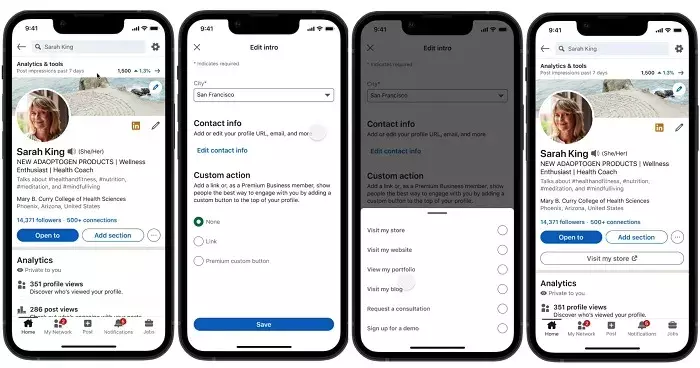In a move that has stirred both curiosity and concern among LinkedIn’s Premium subscribers, the platform recently announced the removal of the option to add custom links to user profiles. This decision marks a significant shift in how LinkedIn perceives the value of customization versus its broader goal of creating a refined, professional atmosphere. Initially introduced as a way for users to drive traffic to external resources—like personal websites or online stores—this feature is now being phased out, igniting discussions about LinkedIn’s strategic direction and user engagement.
Custom links were more than just an aesthetic addition; they represented a potent tool for professionals aiming to unify their online presence and drive attention to their work. The feature allowed for the inclusion of dynamic call-to-action (CTA) buttons, such as “Visit my Store” or “Check my Website.” However, LinkedIn has now decided that removing these options will enhance the overall integrity of its platform, suggesting that such features could dilute the user experience or even lead to potential misuses. But is this truly a move toward improvement, or is it a missed opportunity to serve their user base better?
User Reactions and Implications
Social media is abuzz with reactions to this decision. Many users are expressing frustration, lamenting the diminishing potential for personalization within a platform that prides itself on professional networking. While LinkedIn argues that they are streamlining their features to focus on value, the removal of customizable links could be interpreted as a step back for individual users, leaving them at the mercy of pre-defined structures that dilute personal branding.
While it’s true that not every profile may see an overflow of traffic from these links, the very essence of LinkedIn is about networking and professional visibility. Being able to direct interested visitors to specific projects or personal initiatives has always been part of building a comprehensive online presence. The decision to remove this feature raises fundamental questions about who LinkedIn seeks to serve. Are individual users genuinely the priority, or are they merely collateral in a landscape shifting towards easier, more manageable company profiles?
The Business Perspective
It’s worth considering the business rationale behind this decision. LinkedIn Premium has reportedly seen substantial growth, boasting around 175 million subscribers, with a notable 50% increase in the last two years. This growth has been bolstered by features that enhance brand visibility, such as Premium Company Pages, which include more prominent CTA buttons for business accounts. This signals LinkedIn’s strategic pivot towards supporting businesses over individual users—a shift that could fundamentally reframe the platform’s identity.
Creating clear distinctions between company and personal profiles naturally enhances opportunities for business engagement. Premium Company Pages returning 10 times the average clicks on custom buttons exemplifies that strategizing towards this demographic can yield greater financial benefits for LinkedIn. Nevertheless, this begs the question: will individuals eventually feel overlooked as the focus continues to shift toward corporate stakeholders?
The Interview with the Future
Additionally, with LinkedIn’s aspirations to court content creators, especially in a time when user-generated content increasingly reigns supreme online, this appears to be an ill-timed decision. Creators thrive on visibility and engagement, and the ability to direct followers to external content has been a substantial part of that strategy. By pulling back on such customizable features for individuals, LinkedIn may miss out on fostering the vibrant community of creators it seeks to cultivate.
Moreover, the lack of transparency regarding the specifics that drove this decision is troubling. LinkedIn merely stated that they are committed to evaluating and iterating existing features, but neglected to clarify why custom links weren’t deemed valuable. Speculations could be made about questionable links affecting the platform’s SEO, but this does little to assuage concerns of existing users who already adopt responsible branding and linking practices.
It’s essential for LinkedIn to listen to its subscribers and assess how these changes truly affect user engagement. The value of empowering users with tools that reflect their individuality should not be understated in a professional world that celebrates uniqueness. Notably, platforms that prioritize customization often find themselves thriving in user satisfaction and subsequent loyalty. By sidelining individual profiles, LinkedIn runs the risk of losing its personal touch and turning into a faceless entity driven solely by corporate gains.
Through sensitive navigation in this evolving landscape, LinkedIn must strike a balance that embraces both corporate interests and the unique identities of its individual users.

